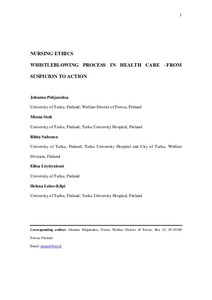Whistle-blowing process in healthcare: From suspicion to action
Pohjanoksa Johanna; Stolt Minna; Suhonen Riitta; Löyttyniemi Eliisa; Leino-Kilpi Helena
https://urn.fi/URN:NBN:fi-fe2021042718549
Tiivistelmä
Background: Whistle-blowing is an ethical activity that tries to end wrongdoing. Wrongdoing in healthcare varies from inappropriate behaviour to illegal action. Whistle-blowing can have negative consequences for the whistle-blower, often in the form of bullying or retribution. Despite the wrongdoing and negative tone of whistle-blowing, there is limited literature exploring them in healthcare.
Objective: The aim was to describe possible wrongdoing in Finnish healthcare and to examine whistle-blowing processes described on the basis of the existing literature in healthcare as perceived by healthcare professionals.
Research design: The study was a cross-sectional descriptive survey. The data were collected using the electronic questionnaire Whistle-blowing in Health Care and analysed statistically.
Participants and research context: A total of 397 Finnish healthcare professionals participated, 278 of whom had either suspected or observed wrongdoing in healthcare, which established the data for this article.
Ethical considerations: Ethical approval was obtained from the Ethics Committee of the University (20/2015). Permission to conduct the study was received according to the organisation’s policies.
Findings: Wrongdoing occurs in healthcare, as 96% of the participants had suspected and 94% had observed wrongdoing. Regarding the frequency, wrongdoing was suspected (57%) and observed (52%) more than once a month. Organisation-related wrongdoing was the most common type of wrongdoing (suspected 70%, observed 66%). In total, two whistle-blowing processes were confirmed in healthcare: (1) from suspicion to consequences occurred to 27%, and (2) from observation to consequences occurred to 37% of the participants.
Discussion and conclusion: Wrongdoing occurs in healthcare quite frequently. Whistle-blowing processes were described based on the existing literature, but two separate processes were confirmed by the empirical data. More research is needed on wrongdoing and whistle-blowing on it in healthcare.
Kokoelmat
- Rinnakkaistallenteet [27094]
